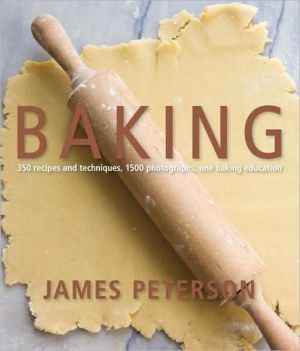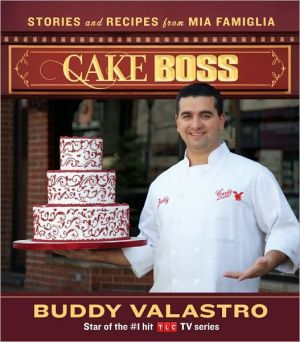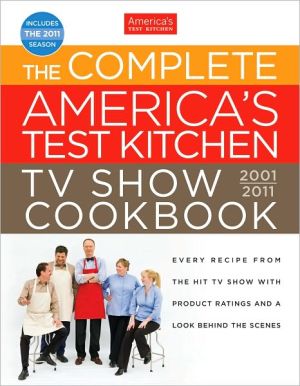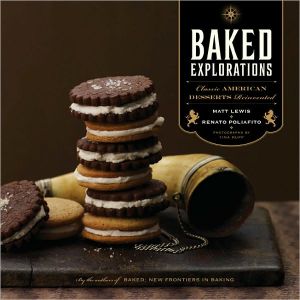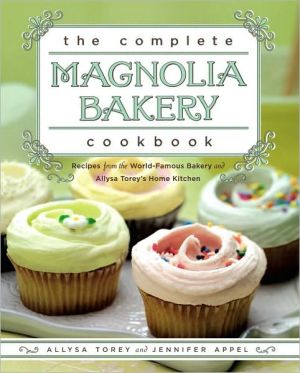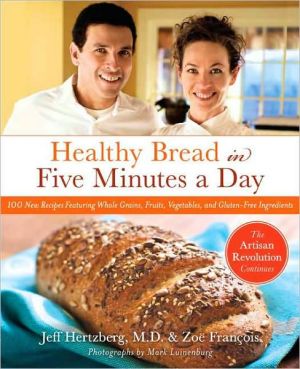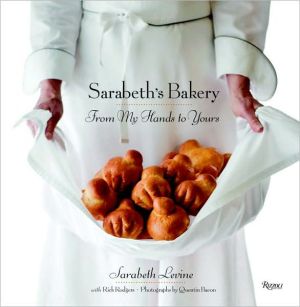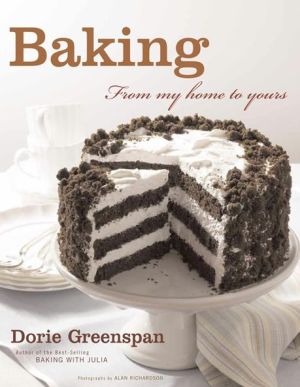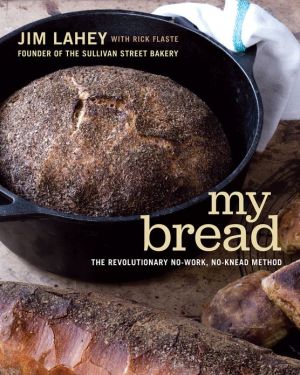Baking
The learn-to-bake master class in a book.\ The craft of baking is based on good technique. Learn the fundamentals well, and you can bake perfect cakes, cookies, tarts, breads, and pastries each and every time.\ That's the premise of Baking, revered cooking teacher James Peterson's master course in baking fundamentals. In more than 350 recipes and auxiliary techniques—most accompanied by illuminating step-by-step photographs—Peterson lays the foundation for lifelong baking success.\ This book...
Search in google:
The learn-to-bake master class in a book.The craft of baking is based on good technique. Learn the fundamentals well, and you can bake perfect cakes, cookies, tarts, breads, and pastries each and every time.That's the premise of Baking, revered cooking teacher James Peterson's master course in baking fundamentals. In more than 350 recipes and auxiliary techniques--most accompanied by illuminating step-by-step photographs--Peterson lays the foundation for lifelong baking success.This book teaches you how to build finished baked goods from their essential components, providing both maximum guidance for less experienced bakers and great creative freedom for more confident bakers. The Cakes chapter, for example, presents basic cake recipes (Moist Sponge Cake, Devil' s Food Cake) followed by frostings, fillings, and glazes (Professional-Style Buttercream, White Chocolate Ganache), allowing you to mix and match endlessly. Or, if you're looking for knockout assembled cakes, go to the end of the chapter and discover complete illustrated instructions for, say, a decadent Chocolate Hazelnut Cake with Chocolate Filling and Hazelnut Buttercream, or an elegant Peach Crème Mousseline Cake. Baking is packed with the basic, must-have recipes for every baker's repertoire (as well as more ambitious classics), such as:Pound Cake • Crème Anglaise • Chiffon Cake • Cheesecake • Classic Puff Pastry • Cherry Pie • Lemon Meringue Pie • Miniature Raw Fruit Tarts • Linzertorte • Cream Puffs • Chocolate Croissants • Cheese Danish • Basic Butter Cookies • Lemon Bars • Biscotti • Challah • Rye Bread • Focaccia • Blueberry Muffins • Scones • Flourless Chocolate Cake • Cheese Souffles • Miniature Cake Petits Fours • Apple Strudel • Napoleons • Rolled Fondant • Bûche de Noël • Éclairs • Mushroom JalousieCopious photographs inspire and help bakers visualize the crucial moments of hundreds of recipes and techniques, including:Troubleshooting Tarts and Pies • Baking "Blind" • Making Liquid Fondant • Coating a Cake with Hot Icing • Assembling a Layer Cake without Using a Cake Stand • Decorating a Cake with a Caramel Cage • Coloring Marzipan • Making a Rolled Cake • Decorating Cookies with Colored Sugar • Filling and Using a Pastry Bag • Kneading Wet Dough in a Food Processor • Scoring Dough • Shaping a Fougasse • Repairing Chocolate Mixtures that Have Seized • Cooking Sugar Syrup to the Soft Ball StageThorough, approachable, and authoritative, Baking shows why James Peterson is a trusted source for home cooks of every level. Work your way through this book, and you will gain the skills you'll need for impressive results every time. Publishers Weekly This workhorse of a guidebook (a sequel title to Cooking by the James Beard–winning author), is a worthy baking school between covers. Jam-packed with instructional photos accompanying a carefully created modular approach that aims to “teach you to think like a baker,” the work features over 300 recipes, mostly classics based in the French tradition. The five chapters—Cakes; Pies, Tarts and Pastries; Cookies; Breads, Quick Breads, and Bread-based Desserts; and Custards, Soufflés, Fruit Curds and Mousses—include a comprehensive overview, sidebars on techniques and recipes designed to teach techniques that can be used in more than the recipe listed. While you won't find innovative recipes, all the basics are here—classic puff pastry dough, sheet cakes, chocolate chip cookies, baguettes—along with classic, fanciful treats such as frangipane tart, madeleines, Grand Marnier soufflés and chocolate croissants. While not glamorous, this is a comprehensive title. (Nov.)
INTRODUCTION\ \ I’m not a natural baker. Whereas when confronted with a stew or roast, I seem to know just what to do, when it comes to baking I need exact measurements and exact directions. And even with instructions in hand I manage to get flour all over the kitchen floor and chocolate on a whole sinkful of dishes. But I do savor the joys of baking: its precision, its particular (and sometimes peculiar) exigencies, and the pleasure of presenting a finished product to my guests or family. As I have progressed as a baker over the last four decades, I’ve gotten a lot of oohs and aahs, which is always extremely gratifying.\ There is no shortage of excellent baking books available. I was motivated to add to the number because it has long seemed to me that most baking books never really explain the rudiments of the art in a way that would allow the reader to build on knowledge gradually acquired. What I hope to bring to the table is an approach that will truly teach you to think like a baker.\ This book was years in the making. As with my other highly illustrated step-by-step books, recipe testing and photography went hand in hand—only this time, I worked with a full-time baking consultant on set. It seemed wise given my proclivities (or lack thereof).\ Baking is organized and written in such a way as to enable you to understand the principles and techniques at play in a given classic recipe, and then to apply what you learn to baking projects that aren’t even included in the book. This means that most of the chapters are organized in a modular fashion. The chapter on cakes, for example, starts with basic recipes for the six different kinds of cakes, then moves on to recipes for frostings, fillings, and glazes. Next come an array of instructions for assembling cakes, such as raspberry buttercream layer cake (page 74), each of which results in a delicious and beautifully decorated cake and also serves as an example of techniques that can be used successfully with myriad other recipes (in the case of the raspberry buttercream layer cake, the main technique illustrated is how to assemble a layer cake without using a cake stand). Or, to take a principle from the chapter on pies, tarts, and pastries, once you realize that pastry dough comes in only five basic varieties, it becomes much easier to master the techniques required to execute a fully decorated pastry.\ Often the difference between an ordinary cake and a fantastic one involves only a simple trick or two. In each chapter and recipe, I have tried to take every opportunity to teach good technique, whether in headnotes and recipe methods or in the many sidebars with stand-alone tips and techniques. Baking describes what can go wrong and how best to avoid common pitfalls such as over- or under-beating, but also how to use little bits of extra knowledge to get great results rather than merely good ones. Thus, Baking is for both novices and experienced bakers seeking to improve the quality of their cakes, tarts, cookies, or breads and make them look as good as the wares in the windows of Fauchon, the famous patisserie in Paris and New York.\ Key to this book’s focus on teaching and technique is its abundant photography—more than 1,500 images that show the most important parts of virtually every technique and recipe described in the text. This step-by-step color photography is indispensable for teaching certain techniques that are next to impossible to explain fully with words. Being able to see how a recipe’s ingredients come together in stages throughout the process of baking reinforces good technique and gives the reader confidence, and a greater ability to get it just right the very first time.\ The art of baking has an implicit logic that lends itself well to such an approach to teaching and learning. The behavior of certain ingredients in combination can be predicted and categorized—in sweet baking, we’re usually concerned with the big four: flour, butter, eggs, and sugar; when making breads, the interactions of water, yeast, and flour matter most. In keeping with the book’s philosophy of providing a solid foundation in baking technique, Baking contains many classic recipes in the French tradition, adapted for use in American kitchens. It’s also a reflection of my own discovery of baking and progress as a baker, starting in my years in France, through my experiments and learning in my own restaurant and those of other chefs, and comprehending also my decades as a food writer and cooking teacher.\ Before you embark on a baking project from this book, I suggest you skim through the rest of the chapter to familiarize yourself with the basic issues and techniques (if you are a less experienced baker) or the tricks of the trade and possibilities for variation (if you are a more experienced baker). It is my hope that Baking will provide a firm foundation in baking fundamentals so you can create perfectly executed classics, feel comfortable diverging from the basic recipes, improvise creations of your own, and dive confidently into any baking recipe you feel inspired to try.\ ASSUMPTIONS\ \ In general, when I cook, I don’t believe in observing a lot of rules—though I do have strong ideas about what works best and tastes best. In baking, this sort of anarchy in the kitchen doesn’t fly; so while I can often choose one flavoring or filling over another, like all other bakers I for the most part adhere to fairly strict rules, which are written into the recipes you’ll find in this book. This section contains some comments on ingredients and equipment that are standard in my recipes.\ \ Ingredients\ Baking powder and baking soda Though both are used as leaveners, don’t confuse baking soda with baking powder. Baking powder contains an acid that causes the bicarbonate of soda to release carbon dioxide. To activate, baking soda needs acid from another source such as from chocolate or lemon.\ \ Use double acting baking powder (this shouldn’t be a problem, as this is probably the only kind you will find at the store). Don’t keep baking powder or baking soda for more than a year.\ Butter Butter is unsalted. If you only have salted butter, just cut down on the salt in the recipe. But do avoid salted butter in very buttery preparations such as buttercream.\ \ Corn syrup Unless otherwise noted, corn syrup is light.\ Cream All the cream called for in this book is either whipping cream or heavy cream, with butterfat content between 36 and 40 percent, never light cream, which has only about 18 to 30 percent butterfat. For the most part, crème fraiche will work as a substitute for heavy cream, but don’t use sour cream unless called for; it has less butterfat.\ Eggs All eggs are large. Brown or white makes no difference.\ Flour All the recipes were tested using King Arthur brand all-purpose flour and Swans Down cake flour. After years of playing with different flours, I’ve found that King Arthur brand, which is fairly high in gluten, will absorb more liquid than softer flours, especially those from the South. If your favorite all-purpose flour is a softer (and thus less absorbent) one, you may not need to use cake flour when it’s called for in the recipe—instead, go ahead and use your softer all-purpose flour on its own.\ Fruit Most of the fruit called for is fresh, but frozen fruit is great for purees. Make sure to buy individually frozen fruit that comes in a bag, not fruit in syrup that comes in a can.\ Nuts Nuts can turn rancid, even in the freezer. The best strategy is to roast them as soon as you get them; this will help their flavor and add to their shelf life. Spread them on a sheet pan and roast in a 350F oven for 15 minutes. Stir around once during the roasting. Once you have roasted them, store nuts in the freezer.\ Nut oils Most nut oils are already rancid before you open the can or bottle. To avoid this, buy nut oils that have been made with roasted nuts, specifically Le Blanc brand. Store nut oils in the freezer.\ Salt Regular fine salt or fine sea salt will do in all these recipes.\ Spirits Spirits used in baking are there to provide flavor, so, buy the best spirits you dare.\ Eaux de vie, such as kirsch or framboise, should be French, German, or Swiss. Bourbon should be straight, not blended. Rum should be dark rum, preferably pot-stilled, from Martinique. Cognac should say Cognac on the bottle and not just brandy. (However, you don’t need to buy an old rare Cognac; a young fruity one will do.) When you add spirits to mixtures such as simple syrup, make sure that the mixture is cool, or the flavor and aroma of the spirits will volatilize and evaporate.\ Sugar Sugar is granulated unless otherwise called for.\ Vanilla Be sure to use real vanilla extract. Use real vanilla beans for infusing in custards and batters.\ Vegetable oil Make sure vegetable oil is fresh, as it can go rancid in a few months. Canola or sunflower oil make good choices for baking.\ Equipment\ \ Bread pans Bread pans come in various sizes and are usually made of aluminum or some other inexpensive metal. In this book, I have used four sizes: miniature 2-cup pans, standard 4- or 6-cup pans, and a large 2-quart pan.\ Cake pans I usually call for standard round cake pans of 9 inches (actually 91/2 inches), though sometimes I specify 8-inch or 10-inch pans (these are also standard sizes). Keep in mind that cakes shrink, such that a cake baked in a 91/2-inch pan will end up being 9 inches. Sheet pans are of a standard size, called a half sheet pan in the industry. They measure approximately 13 by 17 inches with 1-inch-high sides.\ Cake racks Cake racks are essential tools for cooling cakes and cookies. Buy at least one large cake rack (the size of a sheet pan) for flipping out sheet cakes. Round cake racks are convenient for individual round cakes.\ Copper bowls Egg whites rise better when beaten in copper. This leaves two choices—a copper bowl designed for beating by hand (make sure you buy a big one so there’s plenty of room to whisk) or a copper insert for your stand mixer. Be sure to clean the copper thoroughly with salt and vinegar before you use it each time. Make sure there is no trace of fat adhering to the bowl.\ Food processor A food processor is indispensable for grinding nuts and for pureeing solid mixtures. It is also useful for making most dough.\ Marble Marble is beloved of pastry bakers, since its cool, smooth surface helps keep buttery dough from warming while it’s being worked. If you decide to buy a marble, buy the largest one you can lift and store. Scraps from a marble yard are a good source.\ Molds and ramekins Baking molds and ramekins are used for tarts and tartlets, babas and savarins, brioche, madeleines, custards, soufflés, and more. For tarts, cookies, and cakes, non-stick or silicone molds are best. If you’re stuck with traditional molds—especially if you are making madeleines or financiers, which love to stick—butter the molds, refrigerate them, butter them again, and then flour them. When buying baking molds, keep in mind that some miniature tartlets require two molds per tartlet (see page 147).\ \ Porcelain ramekins come in handy for custards and soufflés. It’s ideal to have two sizes—5- or 6-ounce and 8-ounce; the recipes in this book call for 5- or 6-ounce ramekins, which are perfect for single-serving custards and soufflés. Crème brûlé dishes, which are shallow porcelain dishes with fluted edges, look dramatic at table. If you don’t have them, use regular porcelain ramekins, or try making crème brûlé in a baking dish and then bringing the dish to the table to serve.\ Ovens Most baking is done on the middle rack of the oven. Placing a pizza stone on the bottom of your oven will help it maintain an even temperature. A convection oven is a great help in baking, as it cooks rapidly and evenly. Puff pastry does especially well in a convection oven. The recipes in this book were developed and tested using a conventional oven. If you have a convection oven, lower the temperature by 50 degrees.\ \ Parchment paper Almost indispensable in baking, parchment paper is now available at most supermarkets. If you can’t find it, substitute waxed paper (which will leave traces of harmless wax on foods), but not aluminum foil, which will leave specks of metal and may tear.\ Pastry bags and tips Buy large pastry bags so you can pipe plenty of mixture, such as the batter for a large cake. Buy an assortment of pastry bag tips, both fluted and plain.\ \ Pastry scrapers and bench scrapers Bench scrapers (also called pastry scrapers and dough cutters) are typically metal, though some are made of plastic. They are versatile tools that can be used to scrape together ingredients on a work surface, transfer ingredients from work surface to a bowl or pan, and cut dough without wrecking its structure, among other things. Some plastic pastry scrapers have one straight and one rounded edge. This allows you to use them on both the work surface and inside bowls for folding mixtures. \ \ Pastry cutters These old fashioned gadgets—essentially a series of stiff wires attached to a handle—are handy for cutting cubes of cold butter into flour when you’re working in a bowl. When working directly on the work surface, use a pastry scraper. When you are mixing dough in a stand mixer or food processor, the machine does the work.\ Pie and tart pans While pie and tart pans come in innumerable sizes, the most common pie pan, and the one used in this book, is 11 inches in diameter from top edge to top edge, leaving about 9 inches of diameter in the middle. Tart pans are harder to standardize. Assume a recipe uses a 9-inch tart pan, unless otherwise specified—this book is filled with tarts made in irregular sizes. A less expensive alternative to a tart pan is a tart ring, which is simply a metal ring that you set on a sheet pan. The sheet pan provides the base for the tart.\ Plastic wrap Plastic wrap is another kitchen essential, good for wrapping cakes or pastries destined for the freezer, or for covering and protecting all sorts of mixtures and finished desserts.\ Pots and pans In general, pots and pans should be heavy, so they cook evenly. In baking, it’s generally best to avoid aluminum pans, which can turn preparations with egg yolk gray and react with acidic ingredients.\ \ Rolling pins If you have a single rolling pin in your kitchen, make it a large wooden pin. I use the traditional French type of pin, which is a large cylinder with no handles. If you feel comfortable with them, rolling pins with handles work well, too. Avoid the Italian pins, which taper at the ends.\ \ Rubber spatulas These are indispensable for folding mixtures, cleaning out bowls and pans, and transferring small amounts of mixtures. While traditionally made of rubber, flexible spatulas nowadays are made of silicone, which lasts longer and won’t burn.\ Stand mixer Perhaps the most useful item in the baker’s kitchen, a stand mixer is great for making pastries, combining all manner of mixtures, beating egg whites, and kneading bread dough. Some stand mixers will even accommodate a copper bowl insert, which is handy for beating egg whites. Most stand mixers come with three attachments: a dough hook, a paddle blade, and a whisk. Each of these is designed with a different stiffness in mind for whatever’s being combined. Usually, it is obvious which is appropriate for the task at hand. For example, unless otherwise noted in the recipe, the dough hook attachment should be used when making bread.\ If you plan on making a lot of bread, you may want to buy a heavy-duty, professional grade stand mixer; otherwise a stand mixer designed for the home kitchen is sufficient.\ Note that directions for whipping (such as egg whites or cream) include times for a stand mixer, unless otherwise noted. For example, to beat 4 egg whites to stiff peaks in a stand mixer will take 1 minute of beating on medium speed and then 1 minute more on high speed. Whipping with a hand-held mixer or by hand will take longer, so rely on doneness cues given in the recipe to know when you’ve whipped long enough.
CAKESBasic CakesBasic French Sponge Cake (Genoise) • 8Moist Sponge Cake • 10Chocolate Sponge Cake • 12Chocolate Soufflé Cakes • 12Fine-Crumb European Sponge Cake (Biscuit) • 14Butter-Enriched Sponge Cake • 16Sour Cream Sponge Cake • 18Almond Flour Sponge Cake • 20Almond Paste Sponge Cake • 22Angel Food Cake • 24Pound Cake • 25German Chocolate Cake • 26Fluffy Light Butter Cake • 28Cream and Butter Sheet Cake • 29Devil’s Food Cake • 30Vanilla Butter Cake • 31Carrot Cake • 32Chiffon Cake • 34Babas and Savarins • 36French Meringue Layer Cake • 38Hazelnut Meringue (Dacquoise) • 40Chocolate Meringue Logs • 41Cheesecake • 42Frostings, Fillings, and GlazesProfessional-Style Buttercream • 45Italian Meringue Buttercream • 46Quick and Easy Orange Buttercream • 46Dark Chocolate Ganache • 50Creamy Chocolate Frosting (Crème d’Or) • 52Dark Chocolate Glaze • 53White Chocolate Glaze • 53Vanilla Custard Sauce (Crème Anglaise) • 54Strawberry Bavarian Cream • 56Classic Crème Mousseline • 57Fruit Crème Mousseline • 58Seven-Minute Frosting • 59Italian Meringue • 60Lemon Glaze • 61Stabilized Whipped Cream • 62Chestnut Cream Cake Filling • 64Rolled Fondant • 67Royal Icing • 67Royal Icing for Cookies • 67Assembled CakesDevil’s Food Cake with Ganache, Chocolate Buttercream, and Chocolate Curls • 71Chocolate Hazelnut Cake with Chocolate Filling and Hazelnut Buttercream • 72Raspberry Buttercream Layer Cake • 74Orange Buttercream Layer Cake • 77Strawberry and White Chocolate Mousse Ladyfinger Cake • 78Dark Chocolate Mousse Cake • 80Mango Crème Mousseline Cake • 81Chocolate Cherry Cake with White Chocolate Glaze • 84Classic Strawberry-Marzipan Cake (Fraisier) • 86Whipped Cream-Covered Chocolate Chestnut Cake • 90Strawberry Bavarian Cake • 92Individual Chocolate Meringue Cakes • 94Chocolate Mousse Dome Cake • 96Peach Crème Mousseline Cake • 99Miniature Cake Petits Fours • 102Rolled Pistachio Buttercream Cake • 104Apricot Jelly Roll • 106Bûche de Noël • 108Marzipan • 109Pies, Tarts, and PastriesBasic DoughsBasic Pie and Tart Pastry Dough (Pâte Brisée) • 130Sweetened Basic Pie and Tart Pastry Dough • 131Extra Buttery Sweet Pastry Dough (Pâte Sablée) • 134Cream Cheese Tart and Pie Pastry Dough • 135Flaky Pie and Tart Pastry Dough • 136Sweet Crisp Pastry Dough (Pâte Sucrée) • 138Linzer Pastry Dough • 140Classic Puff Pastry Dough • 148Quick Puff Pastry Dough • 151Puff Pastry Cases • 152Puff Pastry Rectangles • 153Cream Puff Pastry Dough (Pâte à Choux) • 155Croissant Dough • 157Fillings and GlazesAlmond Cream • 159Frangipane • 159Pastry Cream • 160Hazelnut Frangipane • 161Praline Paste • 161Cream Cheese Tart Filling • 161Cheese Danish Filling • 162Goat Cheese Filling • 162Mushroom Filling (Duxelles) • 162Liquid Fondant • 163Chocolate Fondant • 163Coffee Fondant • 163Pies, Tarts, and PastriesBlueberry Pie • 164Cherry Pie • 167Apple Pie • 169Classic French Apple Tart • 170Tarte Tatin • 173Plum Tart • 174Apricot Frangipane Tart • 175Blueberry Frangipane Tart • 176Hazelnut or Almond Tartlets • 176Apricot Tartlets • 177Cherry Tartlets • 178Berry Frangipane Tartlets • 178Plum, Kiwi, or Peach Frangipane Tartlets • 178Raw Fruit Tarts • 179Ganache Tart • 179Raspberry-Ganache Tart • 179Kiwi-Whipped White Chocolate Ganache Tart • 180Raspberry-Classic Crème Mousseline Tart • 180Blackberry-Peach Mousseline Tart • 180Mixed Berry-Passion Fruit Mousse Tart • 181Miniature White Chocolate Ganache Tartlets • 181Miniature Dark Chocolate Ganache Tartlets • 181Assorted Berry Tartlets • 182Red Currant Barquettes • 182Miniature Raw Fruit Tartlets • 182Blackberry-Lemon Cream Tart • 183Passion Fruit Meringue Tart • 184Lemon Meringue Pie • 184Alsatian Apple Tart • 186Roast Pear Clafoutis • 188Roast Pears in Butterscotch Sauce • 188Pumpkin Pie • 191Persimmon Tart or Tartlets • 191Passion Fruit Tartlets or Tart • 191Pecan Pie • 192Lime Tart • 194Key Lime or Lemon Tart • 194Orange Tart • 194Candied Orange Slices • 195Banana Cream Pie • 196Coconut Cream Pie • 199Crispy Apple Tart • 201Puff Pastry Pear Frangipane Tart • 201Fruit-Hazelnut Puff Pastry Tartlets • 202Miniature Puff Pastry Fruit Tartlets • 203Individual Deep-Dish Berry Pies • 204Blueberry Turnovers • 205Almond-Puff Pastry Galette (Pithiviers) • 206Linzertorte • 209Éclairs • 210Cream Puffs • 213Cream Puff Pastry Swans • 214Croissants • 216Chocolate Croissants • 219Fruit Danish Tartlets • 220Fruit and Cheese Danish Purses • 222Miniature Cheese Danish Twirls • 223Fruit Danish Packets • 224Rolled Danish Pastries • 225Napoleons • 226Apple Strudel • 228Pistachio Baklava • 232Mushroom Jalousie • 234Cheese Puffs (Gougères) • 235Cheese Straws • 236Vol-au-Vents • 237Miniature Vol-au-Vents • 237Quiche Lorraine • 238COOKIESBasic Butter Cookie Dough • 246Jelly Cookies • 247Holiday Butter Cookies • 248Sablée Cookies • 250Chocolate Sablée Cookies • 250Checkerboard Sablée Cookies • 250Marbled Sablée Cookies • 252Spiral-Patterned Sablée Cookies • 252Shortbread Cookies • 256Pecan Fingers • 257Chocolate Chip Cookies • 259Madeleines • 260Cakey Madeleines • 261Financiers • 262Cat’s Tongue Cookies (Langues de Chat) • 263Almond Tuiles • 264Lacy Blood Orange Tuiles • 265Macarons • 266Coconut Macaroons • 267Florentine Almond Cookies • 268Biscotti • 269Palmiers • 271Brownies • 272Lemon Bars • 274Breads, Quick Breads, and Bread-Based DessertsYeasted BreadsWhite Bread (Straight Dough) • 304White Bread (Sponge Starter) • 306White Bread (Mature Starter) • 307Ciabatta • 309Sourdough Bread • 313Rye Bread • 314Sourdough Whole Wheat Bread • 316Sourdough Whole Wheat Raisin Bread • 316Pumpernickel Bread • 318Pizza Dough • 319Pizza Margherita • 320Roquefort and Walnut Pizza • 320Pita Bread • 322Bread Sticks (Grissini) • 323Focaccia • 324Brioche • 327Panettone • 328Challah • 330Coffee Cakes • 333Cinnamon Rolls • 334Sticky Buns • 336Quick Breads and Bread-Based DessertsBanana Nut Bread Muffins • 338Apricot Bread • 339Popovers • 340Blueberry Muffins • 341Baking Powder Biscuits • 342Scones • 343Cherry Cobblers • 344Strawberry Shortcakes • 345Apple Charlottes • 346Custards, Soufflés, Fruit Curds, and MoussesCoffee Pots de Crème • 353Crèmes Caramels • 355Crèmes Brûlées • 357Cheese Soufflés • 359Grand Marnier Soufflés • 362Lemon Curd • 364Passion Fruit Curd • 364Passion Fruit Mousse • 365Classic Chocolate Mousse • 366White Chocolate Mousse • 367Flourless Chocolate Cake • 368
\ From Barnes & NobleThe brevity of James Peterson's titles is matched by the appeal of his books. His Cooking and Essentials of Cooking are justly regarded as exemplary illustrated instructional manuals. With Baking, the James Beard Award-winning chef turns to a specialty that stymies even veteran kitchen workers. Peterson doesn't profess to transform you into a four-star pastry chef; he intends instead to "teach you to think like a baker." To achieve that high aim, he provides meticulous, step-by-step instructions, accompanied by his trademark photographs, which are designed to teach, not serve as mere eye candy. Baking is divided into five luscious chapters: "Cakes"; "Pies, Tarts and Pastries"; "Cookies"; "Breads, Quick Breads, and Bread-based Desserts"; and "Custards, Soufflés, Fruit Curds and Mousses."\ \ \ \ \ Publishers WeeklyThis workhorse of a guidebook (a sequel title to Cooking by the James Beard–winning author), is a worthy baking school between covers. Jam-packed with instructional photos accompanying a carefully created modular approach that aims to “teach you to think like a baker,” the work features over 300 recipes, mostly classics based in the French tradition. The five chapters—Cakes; Pies, Tarts and Pastries; Cookies; Breads, Quick Breads, and Bread-based Desserts; and Custards, Soufflés, Fruit Curds and Mousses—include a comprehensive overview, sidebars on techniques and recipes designed to teach techniques that can be used in more than the recipe listed. While you won't find innovative recipes, all the basics are here—classic puff pastry dough, sheet cakes, chocolate chip cookies, baguettes—along with classic, fanciful treats such as frangipane tart, madeleines, Grand Marnier soufflés and chocolate croissants. While not glamorous, this is a comprehensive title. (Nov.)\ \ \ Library JournalCooking and baking require two different sets of culinary skills. Professional chef and culinary teacher Peterson (Essentials of Cooking) understands the differences between the two, and here he distills four decades of his own experiences as a cook learning to bake into a master class on the subject. The recipes included are for tried-and-true classics found in any good French bakery, but where Peterson really excels is in the clear step-by-step instructions for creating each delicious treat, showing cooks how to build on the principles learned in one recipe for further culinary projects. Anyone who wishes to acquire a solid foundation in baking (and is willing to put in some serious time in the kitchen) will find this practical guide invaluable. VERDICT There is no shortage of excellent baking titles, including Flo Braker's classic The Simple Art of Perfect Baking and newer treasures such as Dorie Greenspan's Baking: From My Home to Yours, but libraries will still want to make room for Peterson's practical, useful introduction. [This is a sequel to Peterson's 2008 James Beard Award-winning Cooking.—Ed.]—John Charles, Scottsdale P.L., AZ\ \
